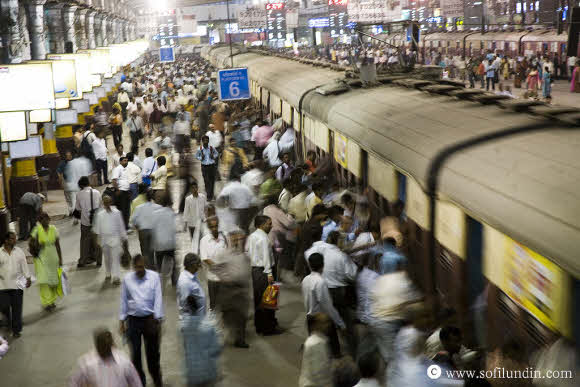by Vani Viswanathan
[box]Trains are an integral part of any image of Mumbai, and being able to efficiently navigate this convoluted system is a mark that you now ‘truly belong’ and are a ‘Bombay girl.’ Vani Viswanathan describes her journey to truly belonging to the city of dreams.[/box]My friend casually grips the pole with one hand and texts with the other, as she precariously dangles at the edge of the ladies coach with one foot in and the other in the air. I, on the other hand, doing the same (minus the texting), am caught between excitement and hyperventilation – it’s been a good eight years since I did anything close to footboard travel, and that too, never on a moving train. My mind wanders to what would happen if my mother ever got to know. An electric pole nears, and even though there are at least five feet between the pole and me, I try to move as far away from it as I can. The woman next to me is asking me to grip somewhere higher as my arm is blocking her face. Why is it taking this long for the train to reach the station?
That I don’t have an issue with using public transport wherever I go is something I’m proud of. Making my way alone while travelling in public transport in other cities – especially if I’m armed with a map – has somehow always made me feel empowered, and I feel some silly happiness in knowing I’m reducing a teeny-weeny bit of pollution because of that decision. So when I moved to Mumbai in 2011, with vague memories of reciting the list of stations from Borivali to Dadar from when I was last here as a seven-year-old, I was incredibly excited and a little nervous. Except for very occasionally using the ‘flying train’ of Chennai, I had hardly had a chance to travel by local train in India, and was worried that Singapore’s rule-based-and-orderly train travellers had spoilt me for good. Friends from Mumbai warned me that the ladies compartment was the worst of the lot, with the pushing and the yelling. The crowds in the ladies compartment were said to be stuff of legend.
I managed the first ride in Mumbai with ease – one of my friends knew what to do, the trains weren’t crowded, and hey, we got seats too. Till date, travelling the length to the Chhatrapati Shivaji Terminus (CST) is the train journey that excites me the most, followed by taking the train to Vashi, crossing the long bridge. Besides the obvious draw of a beach in CST and the Vashi journey that includes going over the creek and boasts the view of a ‘skyline’ dotted pretty with lights at night, the fact that these trains are often less crowded is an influential factor.
 Ah, but Mumbai was just easing me in with these train rides. In the nearly two years since, I have seen the best and worst of it. I have been yelled at in furious Hindi and been stumped because my Hindi fails me when I need it the most (to yell back) and mutely, with a scorn on my face, I’ve had to move in ‘because I’m not alighting at Kurla.’ I have been offered space to sit by three women who willingly squeeze into a seat for three. On at least two occasions, I have snapped at women who adjusted my kurta for exposing some tiny inch of skin, and have been stared at by groups of men and women when I made the mistake of taking the local train in a dress because of a sudden change in plans. One woman regaled me and my friends with proud stories of her little son who sat there shyly avoiding meeting our eyes. iPod on, I have spent wonderful hours watching people talk to strangers, meet acquaintances they have made from shared train travel, hawkers selling everything from accessories to stationery to fruits to fried eatables to plastic items that I wistfully remember having spent hours trying to find in Singapore. I have been petty and tried to edge more space out of the woman who was sitting with her legs spread out a little more than acceptable in a crowded train. I have looked half with admiration and half with amusement at women wearing their makeup or women propping their legs on the opposite seat and working on their laptops. I have seen solidarity among the women as they offer to hold babies or bags, or mark a particular woman as the one who will get her seat when she leaves. I have seen women yell at each other so much that if they had the space, the fight would definitely become physical.
Ah, but Mumbai was just easing me in with these train rides. In the nearly two years since, I have seen the best and worst of it. I have been yelled at in furious Hindi and been stumped because my Hindi fails me when I need it the most (to yell back) and mutely, with a scorn on my face, I’ve had to move in ‘because I’m not alighting at Kurla.’ I have been offered space to sit by three women who willingly squeeze into a seat for three. On at least two occasions, I have snapped at women who adjusted my kurta for exposing some tiny inch of skin, and have been stared at by groups of men and women when I made the mistake of taking the local train in a dress because of a sudden change in plans. One woman regaled me and my friends with proud stories of her little son who sat there shyly avoiding meeting our eyes. iPod on, I have spent wonderful hours watching people talk to strangers, meet acquaintances they have made from shared train travel, hawkers selling everything from accessories to stationery to fruits to fried eatables to plastic items that I wistfully remember having spent hours trying to find in Singapore. I have been petty and tried to edge more space out of the woman who was sitting with her legs spread out a little more than acceptable in a crowded train. I have looked half with admiration and half with amusement at women wearing their makeup or women propping their legs on the opposite seat and working on their laptops. I have seen solidarity among the women as they offer to hold babies or bags, or mark a particular woman as the one who will get her seat when she leaves. I have seen women yell at each other so much that if they had the space, the fight would definitely become physical.
Am I romanticising the whole experience? Yes, to a large extent – it’s hard not to, when you’re talking of something legendary, something that is a big definition of the city you have grown to love. Am I making it sound like a rosy people-watching experience though? That it definitely is not.
With only two or three second class coaches allotted for women, it’s a nightmare if you are in the wrong train at the wrong time. The worst train journey for me would be when I boarded the very train to Thane that my relative advised me to avoid – the one that goes to Ambernath. I don’t know how I managed to get in, but thank heavens I am an inch or two taller than the average Indian woman, for that is the only reason I didn’t faint in the crowd. Squished next to me was a woman with an infant in her arms and a little daughter who had disappeared in the mass of bodies. We arrived at Thane after an eternity (plus a 15-minute-delay), and the women crowding at the exit to leave this wretched train as soon as possible suddenly realised the train was going to a different platform, which meant they would have to alight from the other exit. Immediately it became the nastiest crowd I have ever been in. The woman with the baby was screaming, and she didn’t know where her daughter was in this frenzied crowd. To this day, I don’t know how I made it out alive, but leave that train I did, after a few minutes (yes, minutes) of agony and pushing as if life depended on it – so much so that my knees were trembling when I stepped out. The daughter was pushed out by some kind stranger soon, and she was crying and was swept up by her father who was also comforting his wife who was shivering and in tears and –wait for it – whose saree blouse was torn. My friend came home once in tears because she was simply unable to alight at her station and was getting yelled at by an extremely rude woman who simply wouldn’t budge to give way. One woman during another journey was crying because her fellow passenger had alighted but she didn’t manage to. You wonder what possesses the female travellers at these hours – is it the crowd? Is it the fear of missing your station? Is it the idea that if you don’t know how to handle this, you shouldn’t be here in the first place? I have wondered if the general compartments are better – are the men equally frantic about getting in and out of the train?
It’s not just about knowing how to handle the people in the train, though, is it? Knowing which train to board, Slow and Fast, what BR, BO, BS etc. mean, or when A is Andheri and when it’s Ambernath, and which stations are skipped in the fast train, and which platform you should rush to when you’re changing trains, are exceptionally tricky. I have longed more than once for the obsessively labelled train stations in Singapore when trying to navigate the Mumbai train platforms. I have boarded a fast train in the opposite direction, ending up wasting 45 minutes in the process. I have wondered how to explain the wrong train ticket in my hands in such circumstances, and decided to make my Hindi more accented to indicate that I’m new to the city and made a mistake.
They say that travelling on the Mumbai local trains marks a rite of passage for someone who wants to belong to the city. I’m still clearly far from it, because I only average about one train ride a month, being a student whose venturing out have somehow been mostly in autos or buses. But if life continues in Mumbai post student life, maybe I will get the hang of it, maybe I will belong.
Vani Viswanathan is often lost in her world of books and A R Rahman, churning out lines in her head or humming a song. Her world is one of frivolity, optimism, quietude and general chilled-ness, where there is always place for outbursts of laughter, bouts of silence, chocolate, ice cream and lots of books and endless iTunes playlists from all over the world. Vani was a Public Relations consultant in Singapore and decided to come back to homeland after seven years away to pursue a Masters in Development Studies. Vani blogs at http://chennaigalwrites.blogspot.com
[facebook]Share[/facebook] [retweet]Tweet[/retweet]




